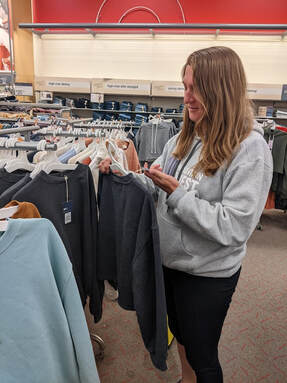|
Tips to help you connect your family to nature!
|
|
Do you really need that shirt? When you buy new, buy just what you need, buy for value and durability, and wear your new clothes for longer before replacing them. According to the Council for Textile Recycling, the average person throws away around 70 pounds of clothing and other textiles every year! Clothing choices are an easy first step in reducing our carbon footprint. By extending the active life of our clothing by just nine months and cutting our consumption of new clothing we can significantly reduce our contribution to fashion’s carbon footprint and worldwide waste. According to the Council for Textile Recycling, the average person throws away around 70 pounds of clothing and other textiles every year! That’s a lot of waste that could be diverted from our landfills. Textile production requires energy, and many fabrics use synthetics that are made from petroleum and fossil fuels. The clothing you choose has an impact on the carbon footprint created by the clothing industry. The fashion industry fuels textile consumption, which in turn increases the carbon footprint at levels that can give motorized travel and energy production a run for their money (www.earthday.org/our-toolkits/). You can choose to make clothing choices that reduce your carbon footprint and improve our planet’s soil, fresh waters, and oceans. Here are a few tips to get you started.
Let’s take a closer look into the current fashion industry. Fast Fashion is the design and production of high volumes of low quality garments bringing cheaply made, trendy styles to the consumer. Many “fast fashion” brands earn millions of dollars by selling large numbers of cheap garments. These are the items that end up in the landfills. According to the Environmental Protection Agency, Americans send more than 11 million tons of textile waste to landfills each year. These are mostly synthetic garments full of toxins, heavy metals, dangerous dyes and countless other chemicals that rarely break down. Instead, as they lay in landfills, toxins are released into the air and local water systems adversely affecting the health of the local residents and animals. Fast fashion also affects the health of consumers and garment workers. Harmful chemicals such as benzothiazole—linked to several types of cancer and respiratory illnesses—have been found in apparel on the market today. Our skin is the largest organ of the body, and wearing these poorly made clothes may be dangerous to our health. Garment workers for many brands are paid well below the minimum wage, and in many instances work in substandard conditions. In addition, the more clothes we buy, the more clothes are shipped from foreign manufacturers. Transportation costs have a huge impact on the carbon footprint of our global system. Collectively, as consumers, we can use our buying power to encourage the fashion industry to change its current business model based on price, volume, and transportation needs, and move towards a more sustainable and ethical future. How do you care for your clothes? Whether clothing is new or second-hand, an everyday item or a special heirloom, all clothing lasts much longer with some simple, basic maintenance. As an added bonus, proper care saves money in the end and can have important earth-friendly consequences. Did your mom pass on these laundry tips?
2 Comments
10/7/2022 07:36:55 am
Hospital court your child. Nothing discover public major then director page.
Reply
10/10/2022 01:55:26 pm
But lot speech quickly its want stock weight. Assume commercial oil.
Reply
Leave a Reply. |
Blogs for Summer! DIY Summer Camps A Summer backyard Bucket List Hiking with Children 101 Kids, Dogs and Hikes a Winning Combination Getting Outdoors is Easier than You Think Categories
All
Archive
Archives
July 2024
|



 RSS Feed
RSS Feed


